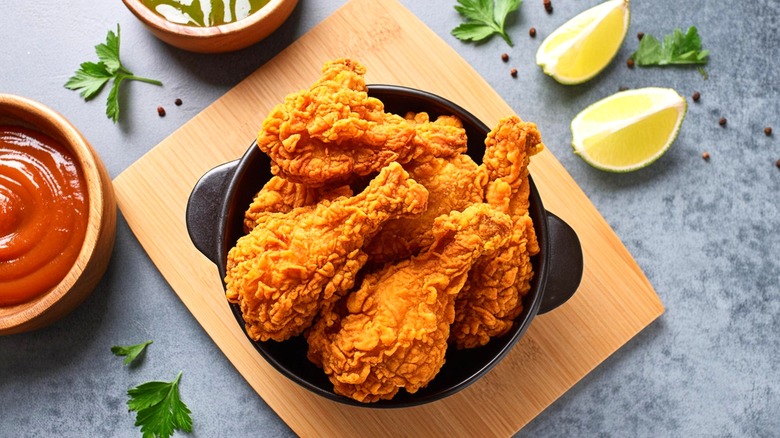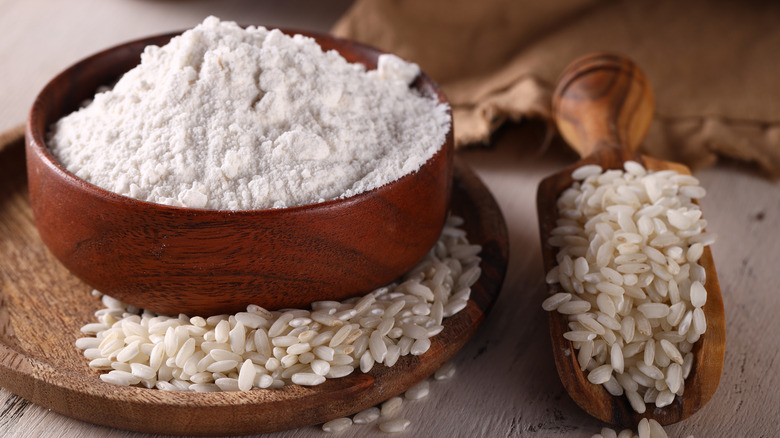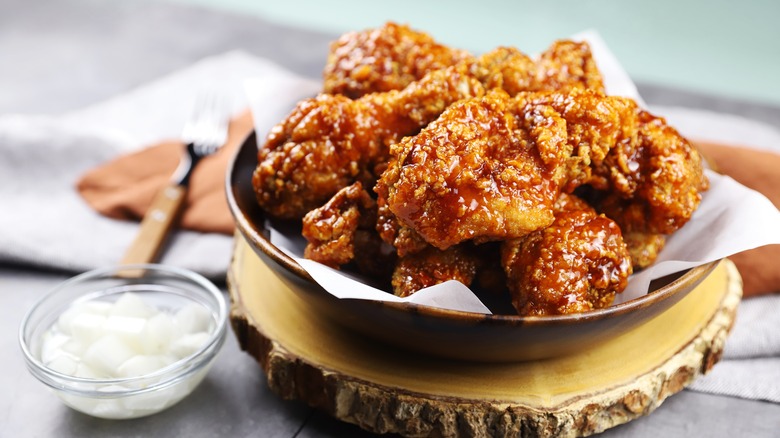The Best Flour To Use When Cooking Homemade Fried Chicken
The crunchiest, most delicious fried chicken involves just a few simple steps — brining and dredging in flour or dipping in a floury batter, then frying until gorgeously golden. But to get the best results, and avoid a soggy coating, you have to use the right kind of flour. While all-purpose flour is a staple pantry ingredient that does the job well enough, there's another type well worth considering: rice flour.
Perhaps more commonly associated with international fried chicken styles such as Korean or Southern Thai, rice flour doesn't absorb as much oil as all-purpose when the chicken is fried. This results in a crispier finish to the chicken, and there is less chance of it becoming overly greasy.
Many well-known chefs and TV personalities are fans of rice flour for frying. Martha Stewart uses rice flour to coat chicken before it's battered and fried (per YouTube). Bobby Flay uses it to make crispy fried fish for tacos (via Today), and Tyler Florence likes to combine it with all-purpose for the ultimate crunchy chicken crumb (per Facebook). As well as making the coating less heavy, rice flour also makes a great gluten-free flour alternative to all-purpose, which may suit some people, like those with celiac disease, better.
Use rice flour for a light and crispy finish
The reason rice flour absorbs less moisture and fat when frying is thanks to its lack of gluten since gluten absorbs both. According to the Southern Regional Research Center, part of the USDA, the oil uptake with rice flour is 50% less than with wheat flour. Choose smooth white rice flour for a crisp and incredibly light result, similar to tempura. Brown rice flour has more flavor, but its grittiness means it's better used in baking or for thickening sauces than for frying.
Besides the textural benefits, rice flour has another advantage over all-purpose flour when frying chicken: The crumb stays crispy for longer, even when it's coated in a sauce. Its finer texture means it browns more quickly in hot oil, though, so it's best to stick to smaller pieces of poultry. Wings, drumsticks, or popcorn-style pieces work well — or cut larger portions, such as breasts, in half.
For an even crispier exterior, add some cornstarch to the flour. It's a trick that Bobby Flay likes to use for the crunchiest bite to his batter (per YouTube). The corn starch also helps to soak up additional moisture from marinades, so the coating won't become soggy. If you're using it as a dry dredge after marinating or brining fried chicken for a juicy result, go for 1½ cups rice flour mixed with ¾ cup cornstarch.
Season the flour for the tastiest fried chicken
For flavorful fried chicken, seasoning is key, so add extra ingredients to the flour for a tasty coating. Try spices such as paprika or cayenne pepper for smokiness and heat, as well as giving the finished fried chicken a great color. Onion powder and garlic powder will ramp up the savory notes — or go for Cajun seasoning for a deliciously robust flavor, or add aromatic herbs such as thyme and oregano for a more fragrant finish. For a delightful brightness, Andrew Zimmern's secret for zesty fried chicken is using dried limes in the flour mix.
To make sure the coating sticks well and doesn't fall off during cooking, you can dredge the brined chicken pieces in seasoned flour, then dip them in buttermilk, and then once again into the seasoned flour. This double dipping will create an extra-crispy coating, too.
Stick to a neutral-tasting oil when frying to allow the flavor of the chicken to shine. You also need something with a high smoke point since the best temperature for frying chicken is between 350 and 365 degrees Fahrenheit. Try something like canola — Bobby Flay's preferred oil — or you could go for safflower or peanut oil as a vegetable oil swap for deep-frying.



